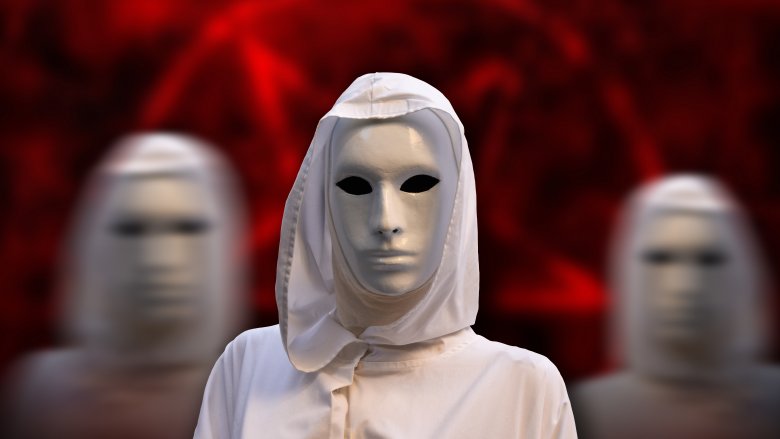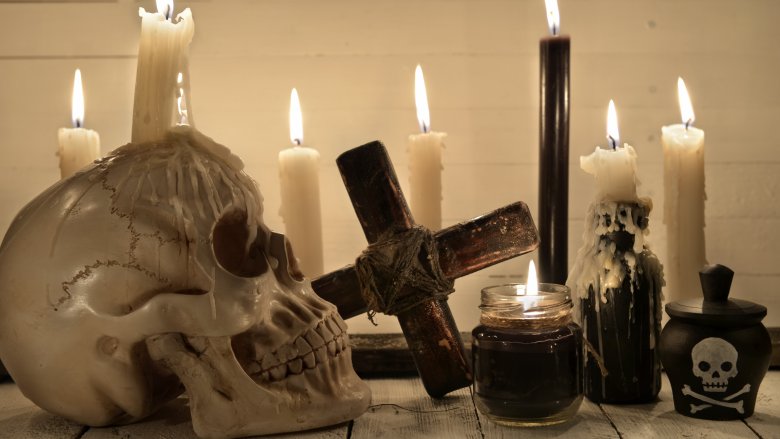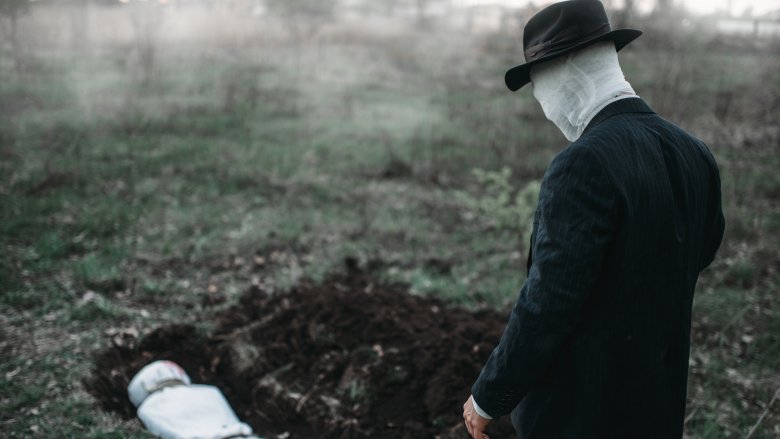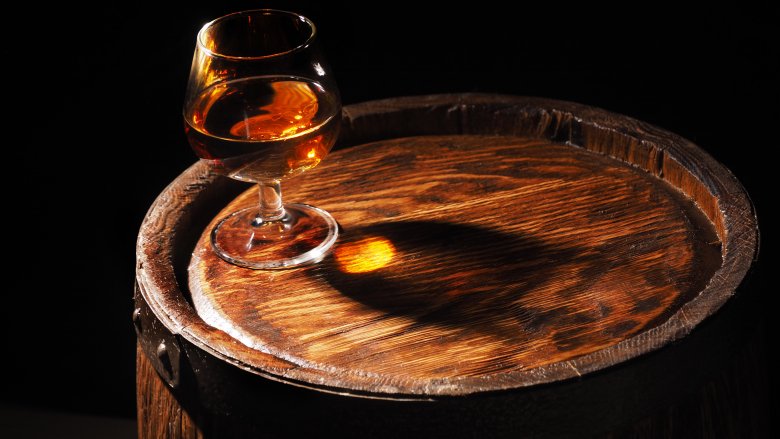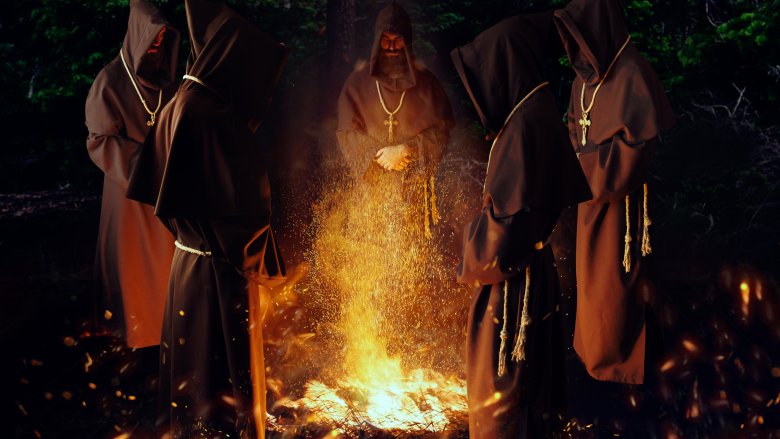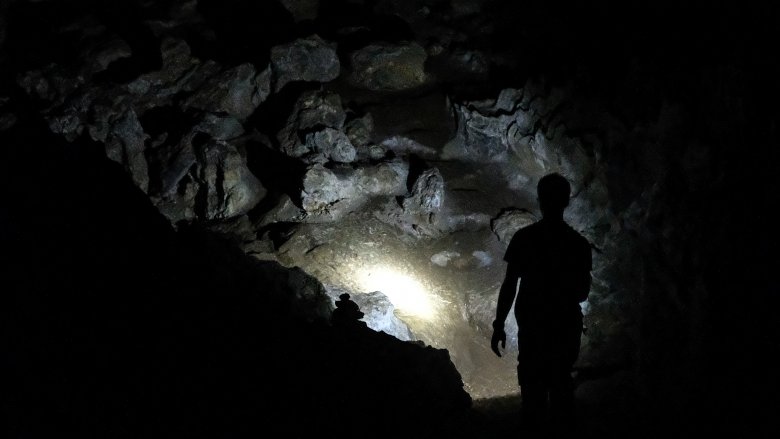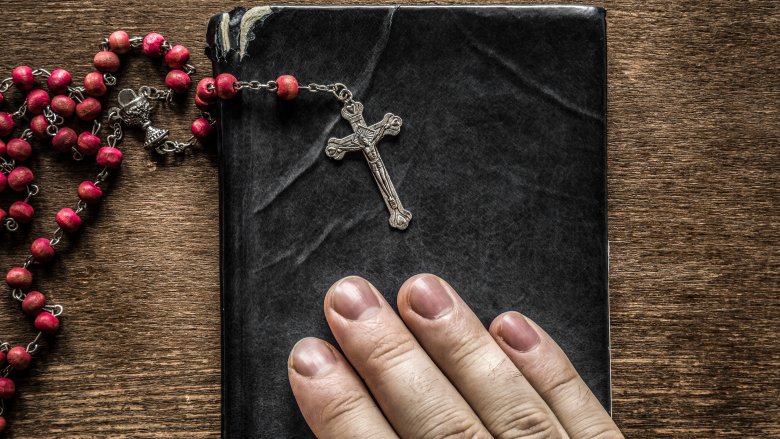What Really Went On In The Hellfire Club
There's a certain sort of extraordinarily rich person who has a ton of time and money on their hands, and not much of an inclination to use those things to benefit society. That's been true throughout history, and in the 18th century some of the richest men in Britain and Ireland decided to fill their nights with activities organized under the guise of a club whose name says it all: the Hellfire Club.
There were a number of "chapters" of the club that sprang up throughout the 1700s, and there are a few crucial points that need to be made. They were definitely not part of an official sort of organization, they were incredibly secretive, and according to Abarta Heritage, they were born from an upper class that had been enraptured by the Enlightenment Philosophy. What does that mean? It means they were testing the boundaries of society and good taste, turning their backs on what they had been taught about morals, and essentially seeing what they could get away with.
Turns out they could get away with a whole lot. The first Hellfire Club kicked off in 1719, run by Philip, First Duke of Wharton. Others sprang up in the following decades and quickly became known for drunkenness, debauchery, orgies, and just a dash of murder. The secretive nature of their members gave rise to a ton of rumors, but were any of them true? Well, yes.
Drinking with the devil and his demons
The members of the Hellfire Clubs had a few things in common: They were rich, had no regard for the morals of society, could keep secrets, and had enough privilege that they could get out of pretty much any trouble they happened to get into. That means the common folk were left to tell stories about what they thought went on behind those closed doors, and those stories explain just what people thought of the club and its members.
Hellfire Clubs were commonly linked with tales of Satanic rituals and demonic dealings. Simon Luttrell was the sheriff of Dublin City when he was in the Hellfire Club, and there were whispered rumors that he'd sold his soul to the Devil ... and the Devil had come to collect (via Abarta Heritage). There's also a story that involves a card game with an unfortunate player who dropped a card. As he bent down to pick it up, he noticed that one of his fellow players had a cow's foot. He regained his composure, but after a few hands he revealed what he'd seen. The hoofed player disappeared, and the man who'd seen his true foot promptly died.
According to popular legend, Dublin's Hellfire Club always left one seat empty in case the Devil decided to join them, during their evenings that began with setting fire to a cat.
Mayhem with a healthy helping of murder
Sometimes, truth is stranger than fiction, and that was the case with Irish Hellfire Club member Henry Barry, Lord Santry. He was just as much of a rake and a drunkard as the rest of them, Abarta Heritage says, but he liked a healthy dose of murder with his mayhem.
Lord Santry employed a sedan chairman to carry him around, and history has recorded what happened to the servant when he was ill and bedridden one day: Santry forced him to drink a quart of brandy, then set the bed on fire.
There's another, similar story credited to Santry, which says he was attending a Hellfire Club meeting when he forced a man to drink so much brandy it filled his stomach and throat, then lit him on fire. He was never prosecuted for that (he had a tendency to bribe people to keep quiet), but he was arrested for events that happened during a gathering of the Hellfire Club in Palmerstown, Dublin.
When someone laughed at Santry, legend says he drew his sword and stabbed a tavern employee. Bribes worked — for a while — but he was eventually put on trial. He attempted to defend himself by claiming the man died from a rat bite, but he was found guilty. Santry only dodged execution because his wealthy, land-owning uncle threatened to cut off Dublin's drinking water, and Santry scored a royal pardon.
The favorite drinking games
Headstuff says mixing fire and booze was a particular pastime of Hellfire Club member Richard Chappell Whaley. He had an unhealthy obsession with fire, so unhealthy that he earned the nickname "Burn-Chapel," and eventually burned Hellfire Club's Montpelier Hill headquarters to the ground after dousing a servant in brandy and setting him on fire.
Again, it's unclear just what's truth and what's fiction because the Hellfire Club most commonly met at the Eagle Tavern, not Montpelier Hill. But historians do seem to agree that club meetings were kicked off with a drink called scaltheen, which was essentially whiskey, butter, pepper, and sugar. The Herald says one of the more popular drinking games they played was drinking "while standing close enough to a roasting fire to melt the marrow in their bones," and basically the last man standing was the winner.
Regardless of whether they were drinking to the devil, they were definitely drinking (via The Hellfire Club). Chapter members in England recorded some of their cocktails, and they were given names like "Gin and Sin" and "Strip Me Naked," which might be some indication of what else was going on there. They also referred to members as three- or four-bottle men based on how many bottles of port they could drink at a time.
Blackmail, secrecy, witchcraft and an execution
Simon Luttrell was one of the more notorious members of Ireland's Hellfire Club, and one biography called him "everything that can be conceived as odious and horrible." Unraveling the story of what happened between him and Darkey Kelly, the madam of a Dublin brothel, is a little complicated but Killer Women gives it a try.
The basics of the most commonly told story are this: Kelly became pregnant with Luttrell's child and tried to blackmail him. He accused her of being a witch, and she was tried and executed. Straightforward enough, but there may have been a little more to it.
Newspaper reports from the time suggest Luttrell — who was a member of the House of Commons and the Sheriff of Dublin at the time — may have had a different role. Kelly's execution came in 1760 (not 1746, as it was claimed) after she was put on trial for the murder of a local shoemaker named John Dowling. Authorities searched her property, found the bodies of five men, and she was found guilty. After unsuccessfully trying to get a stay of execution (for a pregnancy she didn't have), she was strangled until she was nearly dead then burned the rest of the way dead.
What gives? According to researchers combing through the National Archives, Kelly's story was probably confused with another scandal involving Luttrell: one where his son was accused of sexually assaulting a teenage girl.
The 'sacrifice of maidens' and mockery of the church
The Hellfire Club was rumored to be in league with the Devil, but historians now know they were doing something sort of similar: They were mocking the church.
During the Enlightenment, people started to question what they had been taking on faith for a long time. The wealthy rakes of the Hellfire Club were highly skeptical of Christianity in particular, and according to one letter written by a member under the pseudonym "Morlock" (via Abarta Heritage), a lot of what they were doing was essentially thumbing their noses at organized religion. Morlock wrote of a club practice called "the sacrifice of the maidens," but historians think it's not entirely what it seems. It was likely taking a woman's virginity, and they were doing it while pledging allegiance to old pagan gods and swearing, in part, "all that is called good by priest-rid fools to entirely abandon, and to let nothing share the least part of my favour but what is solely urged by most vicious and libidinous desires."
When Philip Wharton first started the Hellfire Club, The Dabbler says it was officially dedicated to "drinking, lewdness, and puerile acts of blasphemy." Members would dress as monks and characters from the Bible, and it seems as though the anti-religious stuff was what authorities really took an issue with — his club was closed in 1721 due to "blasphemy and profaneness."
Underground tunnels for an underground society
When Sir Francis Dashwood formed his drinking-and-debauchery club in the 1750s, he called it the Knights of Sir Francis of Wycombe. Kerry Ann Williams, who works on the West Wycombe Estate, says the "Hellfire Club" label came later — but it stuck.
She also told the BBC that beneath Dashwood's estate is a series of tunnels, but no one really knows why he had them dug, what all the little rooms were used for, or what went on in the Inner Temple. That's an extra-secret room at the bottom of a series of secret rooms, so off-limits that the highest-ranking members could only access it by boat.
There are some clues as to what went on there. Silverware and drinking vessels have survived, and Williams says wine and women were undoubtedly the most popular things in the caverns. She also says historians were really, really close to having complete documentation of all Hellfire Club activities, as Paul Whitehead acted as the club's steward and recorded everything that went on, down to what silverware was used. Unfortunately for history, he spent the three days prior to his death burning all club records.
There is a strangely happy footnote to this all, though: Dashwood ordered the caves excavated as a way to provide jobs for locals who were suffering through a series of crop failures.
Sacrifices to Bacchus and Venus
The Rake described Philip Wharton's original Hellfire Club this way: "His goal was to deride religious faith by publicly presiding over a feast of Christian ritual parody, with plenty of satanic trappings ladled over the top." But dotted throughout the stories of drunken orgies are mentions of other divine figures: Bacchus, god of wine, and Venus, the goddess of love.
Dashwood was in Italy when he developed his seething hatred of the Roman Catholic Church, and even before his "knights" assembled first in London's George & Vulture pub, he had a certain fondness for commissioning some of the era's finest artists to do insanely blasphemous portraits of him — including one where he ogles a statue of Venus. For his club, he "acquired" Medmenham Abbey and inscribed the motto "Fay ce que vouldras," or "Do what thou wilt" over the door.
City of Sin says Dashwood built a temple dedicated to Bacchus on his estate and became obsessed with the idea his estate encompassed an old pagan site. When he had his labyrinth of caves excavated, he made sure the ancient deities were included. According to the era's "coffee-house gossips," part of the rituals that went on there were "sacrifices" to both Bacchus and Venus, "and the nymphs and the hogsheads that were laid in against the festivals of this new church, sufficiently informed the neighbourhood of the complexion of those hermits."
Those hermits were, of course, Dashwood and his colleagues.
Political beliefs and baboons
The members of the Hellfire Club were all among the upper crust: lords and earls, military officers, members of Parliament. According to the New York Times, politics and debauchery weren't always separate, and on at least one occasion a prank gone wrong may have caused a division that made its way into real life.
John Wilkes was a poet and controversial politician who was ousted from Parliament, says Britannica, because of charges of libel brought by John Montagu, Lord Sandwich (and yes, it's that Sandwich). Wilkes and Thomas Potter (the son of the Archbishop of Canterbury) had taken Alexander Pope's Essay on Man and written a parody: Essay on Woman, which the John Wilkes Club says is often called one of the dirtiest poems in the English language. Wilkes had been in the process of printing 12 copies — likely for his fellow Hellfire Clubbites — when Sandwich brought charges against him.
Why? Because, the story goes, Sandwich hated him. Wilkes had decided it would be hilarious to dress a baboon as the Devil and let it loose during one of the club's "services" in Dashwood's Medmenham Abbey. Sandwich — fully believing it was the Devil coming to get his soul — fled as fast as he could, and never lived it down or forgave Wilkes. After the libel trial, Wilkes was found guilty, fled to France, and was declared an outlaw.
Systematic blasphemy
So, what happened to the Hellfire Club? According to Blasphemers and Blackguards, it was blasphemy that authorities really, truly had the biggest problem with.
In 1738, a painter named Peter Lens found himself under investigation by the Committee for Religion. He was a self-confessed member of the "Blasters" (likely just another name of Dublin's Hellfire Club), who had become very well-known for publicly praying to the Devil — actions which were meant to be not only an attack on organized religion, but were a sort of ill-advised way of speaking out against social norms. Members did more than pray to the Devil, they even disrupted church services. In reality, they no more believed in the Devil than they believed in God, and they just used blasphemy as a way to offend the establishment.
Even though there have been artifacts — tables, snuff boxes, and even medals — that seem to show diabolical imagery, that doesn't mean they actually worshiped the devil. Historians think any rites and rituals were done in part to heighten the club's mysterious image, and in part because they thought it was just pretty hilarious. No one else did, and Lens was ultimately arrested for his blasphemous and disruptive actions.
A bit of suggestive gardening
There's a lot of mystery when it comes to just what went on during rituals at the Hellfire Club meetings, and while there were definitely some members who were more into murder than mayhem, there's one anecdote that speaks volumes to the mentality of the men in the club.
High above Francis Dashwood's estate, Slate says, is a gold sphere perched on the top of the Church of St. Lawrence. There's just enough room inside for a few people to look out not only over the countryside, but over Dashwood's gardens — which just happened to have been planted in the shape of a curvaceous and very naked woman. Not only did the gardening feature some carefully placed pink rose bushes and triangles of forest, but there were also strategically placed fountains that could be turned on with a signal from Dashwood.
Dashwood was reportedly a fan of taking members of the clergy up into the sphere to see his massive lady-garden, and according to the modern Dashwood descendant in charge of the estate, Sir Edward, a lot of what actually went on at the Hellfire Club was all in good fun. "Sir Francis wasn't crazy," he says. "He was just a tremendous character. And he had bloody good fun. ... They all dressed up and drank a hell of a lot."
Is that all?
